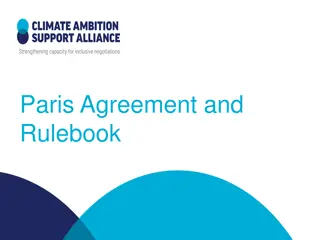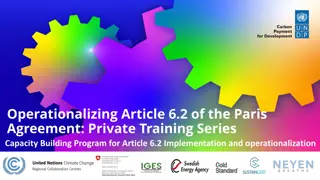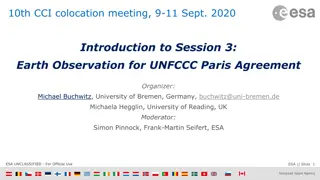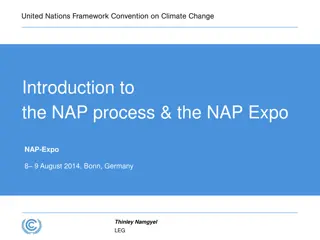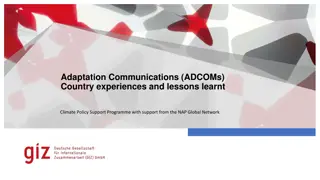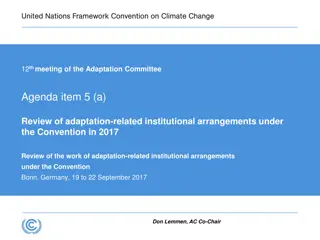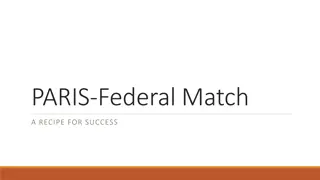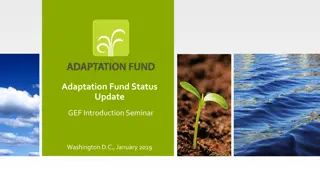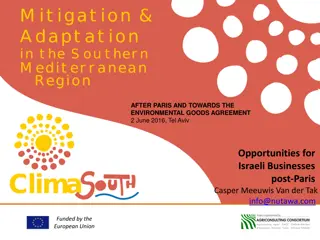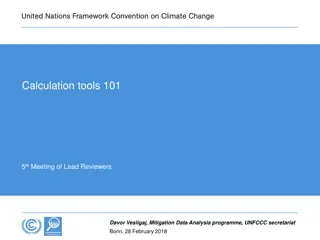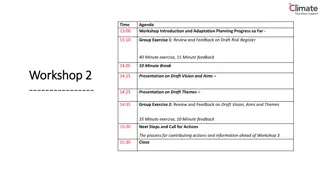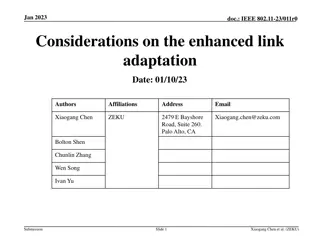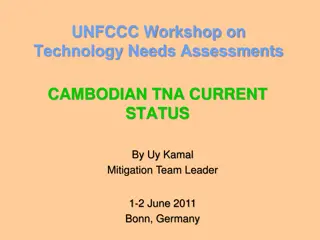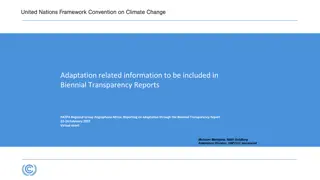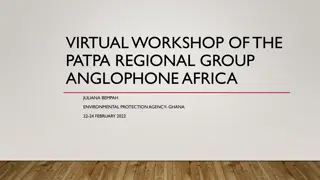Workshop on Adaptation Reporting under the UNFCCC and Paris Agreement
Workshop on Adaptation Reporting through the Biennial Transparency Reports and related work by the Adaptation Committee under the UNFCCC and the Paris Agreement, focusing on arrangements for reporting and communicating adaptation information. The workshop covers various initiatives, guidelines, and processes aimed at enhancing transparency, consistency, and comparability of adaptation actions globally. Future plans include developing supplementary guidance for Adaptation Committee members by June 2022 for effective communication of adaptation information.
Download Presentation

Please find below an Image/Link to download the presentation.
The content on the website is provided AS IS for your information and personal use only. It may not be sold, licensed, or shared on other websites without obtaining consent from the author. Download presentation by click this link. If you encounter any issues during the download, it is possible that the publisher has removed the file from their server.
E N D
Presentation Transcript
PATPA workshop on Adaptation reporting through the biennial transparency reports Adaptation information arrangements under the UNFCCC and the Paris Agreement, and related work by the Adaptation Committee 22-24 February 2022 Ms. Funanani Muremi, Adaptation Committee member
UNFCCC AND PARIS AGREEMENT ARRANGEMENTS INVOLVING ADAPTATION INFORMATION REPORTING AND COMMUNICATION WITH ADAPTATION-SPECIFIC GUIDELINES 1999: National communications of annex I Parties (FCCC/CP/1999/7) NC portal 2019: new guidelines (6/CP.25) NC portal 2002: National communications of non-annex I Parties (17/CP.8) Public registry 2015/2018: ADCOMs (PA Art 7 + 9/CMA.1) UNFCCC website 2015/2018: BTRs (PA Art 13 + 18/CMA.1) NATIONAL-LEVEL ADAPTATION PROCESSES WITH REPORTING / COMMUNICATION ASPECTS UNFCCC website 2001: NAPAs NAP Central 2010: NAPs (5/CP.17) OTHER INFORMATION CHANNELS NDC registry 2014: Adaptation components of INDCs/NDCs (1/CP.20) UNFCCC website Low-emission development strategies (PA Art 4.19)
UNFCCC AND PARIS AGREEMENT ARRANGEMENTS DESIGNED FOR REPORTING AND COMMUNICATING ADAPTATION INFORMATION Guidance Purpose Timeframe s Every 4 y (8thNCs due on 31 Dec 2022) Process Other information NCs of Annex I Parties - Decision 6/CP.25, paras 46-47 - Enhance transparency, consistency and comparability - Enable review and assessment of implementation - Monitor progress on UNFCCC goals - Encourage consistency, transparency and comparability - Policy guidance to operating entities of financial mechanism - Ensure COP has sufficient information for assessing implementation - Visibility and profile of adaptation, balance with mitigation - Strengthen adaptation action/support - Input to GST - Enhance learning and understanding of adaptation needs and actions - Contribute to reviewing progress towards global goal on adaptation - Secretariat posts NCs on UNFCCC website - Compilation and synthesis NCs of non- Annex I Parties - Decision 17/CP.8, paras 3-4 and 26; section B (paras 28-36) Determined by the COP generally every 4 y - Secretariat posts NCs on UNFCCC website - Guidelines under revision by SBI ADCOM - PA Art. 7.10- 11 - Decision 9/CMA.1 Submit in time to inform each GST - Submitted as components or in conjunction with other documents (e.g. NC, NDC, NAPs, BTRs) - Recorded in registry - Synthesized for GST - Take stock of guidance in 2025 and revise if needed - Country-driven, flexible; not a burden or basis of comparison/review - Information may be tailored to vehicle documents - Parties invited to include ex ante information / provide information on elements (a-d), and additionally (e-i) BTRs - PA Art 13.8 - Decision 18/CMA.1 - Understand adaptation action, good practices, priorities, needs and gaps, to inform GST - Could facilitate recognition of adaptation efforts of developing countries Every 2 y, starting 31 Dec 2024 - Secretariat posts BTRs on web and synthesizes them - Synthesized for GST - Parties may cross-reference adaptation information in other documents, and focus on updates
DRAFT SUPPLEMENTARY GUIDANCE FOR ADCOMS: WORK SO FAR AC to develop, by June 2022, draft guidance for communicating information on the elements of ADCOMs Engagement of IPCC WG II and using existing guidance as a starting point For consideration by SBs at SB57 (Nov 2022) in context of consideration of AC report 9/CMA.1 Agreed on a timeline Considered a mapping of existing guidance and initial outline of draft guidance AC 15-17 Considered successive drafts AC 18-19 Webinar to discuss the guidance with Parties and experts June 2021 19 August: AC discussion on the draft guidance Draft published on 31 August August 2021 AC considered draft and agreed to enhance engagement with IPCC and other stakeholders Draft shared with IPCC, along with specific questions AC 19
DRAFT SUPPLEMENTARY GUIDANCE FOR ADCOMS: OVERVIEW OF THE CURRENT DRAFT Chapter Sections Types of content Chapter 1 Mandate, approach, overview of content Chapter 2 (Part I): guidance relevant for the ADCOMs 2.1: Existing guidance for ADCOMs in Paris Agreement and CMA decisions 2.2: Submitting an ADCOM as a component of, or in conjunction with, other communications and/or documents: relevant guidelines and considerations 2.3: Scope of, and information synergies with, existing guidelines for the main vehicle documents 2.4: Considerations and observations Existing guidance for ADCOMs and vehicle documents, ways in which an ADCOM can be submitted, and synergies between the various guidelines. For each element of ADCOMs identified in 9/CMA.1: (a) what the element can be understood to encompass; (b) how information on the element appears in other UNFCCC reporting guidelines; (c) what information sources are available to inform the preparation of information on that element. Observations and suggestions by the AC. Examples of how ADCOMs have been prepared, based on submitted ADCOMs. Detailed comparison of how adaptation-related information features in guidelines for ADCOMs, NCs, NAPs and BTRs. Chapter 3 (Part II): supplementary guidance to facilitate the preparation of information on specific elements 3.1. Communicating information on possible elements of an adaptation communication: relevant linkages, existing approaches and methodologies 3.2. National circumstances, institutional arrangements and legal frameworks 3.3. Impacts, risks and vulnerabilities 3.4. National adaptation priorities, strategies, policies, plans, goals and actions 3.5. Implementation and support needs of, and provision of support to, developing country Parties 3.6. Implementation of adaptation actions and plans 3.7. Adaptation actions and/or economic diversification plans, inc. those that result in mitigation co-benefits 3.8. How adaptation actions contribute to other international frameworks and/or conventions 3.9. Gender-responsive adaptation action and traditional knowledge, knowledge of indigenous peoples and local knowledge systems related to adaptation 3.10. Any other information related to adaptation Chapter 4: concluding observations Annex I: examples of national processes for preparing an ADCOM Annex II: comparison of types of adaptation- related information under UNFCCC guidelines
DRAFT SUPPLEMENTARY GUIDANCE FOR ADCOMS: NEXT STEPS 15 March 22 March (TBC) 28-31 March March June Next draft published Expert meeting with stakeholders, including IPCC Consideration of draft by AC 21 Revision and finalization of guidance
Thank you! ac@unfccc.int Ms. Funanani Muremi, Adaptation Committee member



